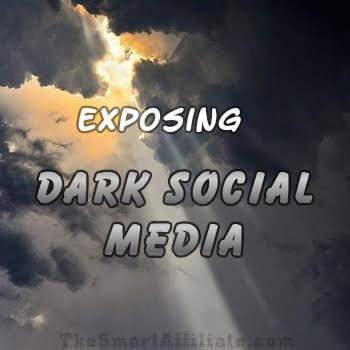Exposing Dark Social Media
Reached another What’s Up Wednesday where I cover a topic that has interesting online marketing consequences. What is it that you should have a concern about?
Web analytics that’s unable to collect complete information leaves a hole about what your potential customers are doing. It is becoming a bigger issue all the time, and that issue is missing stats from dark social media.
What is dark social media?
RadiumOne defines dark social media as any inbound web traffic coming to your site from sources unknown and that traditional web analytics (Google Analytics) are unable to track. How is this possible?
It usually happens when people share online content by copying a URL or picture and pasting it into messaging platforms. Platforms like emails, forums, or instant messaging (IM) rather than sharing it through popular social networks that can be tracked.
As an online marketer, why should I be concerned?
If you have any interest in knowing where your visitors are coming from, what is working with your traffic and ad campaigns, and want to know more about your potential customers, then you should be concerned.
It’s believed that 56% of all US online sharing activity now occurs within the untrackable ‘dark social channels’. That’s compared to 31% from Facebook, and 10% from all other trackable social network channels combined! That can put a dent into any marketer’s day.
What most web analytics fail to track
The problem is most web analytics can’t track sharing that occurs between friends using email, text messages or IM. It can only track the more public stuff among traditional social networks.
Whenever people share content or make recommendations through dark social channels, marketers are missing out on large chunks of data. They’re missing out on preferences, interests, and intended purposes when making planning and ad buying decisions.
Also, the content people share between their connected group with dark channels is most likely to be different from what they share in public posts on traditional social networks. That means marketers are missing a whole other aspect of their customers interests and intent.
Is there an answer to this dilemma?
A link shortening service may be one way marketers can discover how and where their content is being shared. Example, when users copy and paste that shorten link into a text message from a social media site, it’s trackable .
Some link shorteners show how many times the link was shared, where it was shard and by whom. Many of the popular URL link shorteners (like bit.ly) can only provide an “unknown” category for links that weren’t shared on normal channels like Facebook, Twitter, and Google plus.
RadiumOne’s po.st link shortener delivers surface-level analytics with their shorten links shared through email and IMs along with the traditional networks.
However, using a sharing widget on your website will give you the most date and can better monitor how and where your content is being shared (email, text messaging, etc) in real-time to help you understand more about a site visitor’s online travels for example.
Final thoughts
Most web analytic programs have a lot to make up if they want to give marketers the insights into how their customers are sharing content through dark social channels including text messages, person-to person emails, even chats.
The good news is since you just read this article, you are more aware of dark social channels that will get your mind thinking about it and find ways to cover those information ‘gaps’.
As always, I enjoy learning what you think and questions that you might have…. so please leave a comment below, thanks! 🙂


Hi Michel!
Very interesting information here indeed, I never really considered the lack of tracking statistics involved as people share links ‘behind the scenes.’ Certainly had me thinking as I read.
I had a thought as I read this, “the content people share between their connected group with dark channels is most likely to be different from what they share in public posts on traditional social networks…” While I don’t have an answer to the tracking issue(lack), my thought… ‘Doug, what are the kinds of things you yourself share behind the scenes?’
Even though we may not have the tracking statistics(yet) – we do have a pretty good idea what we share with friends and family ourselves – as marketers we can send out material we know will get shared behind the scenes.
Create ‘dark social media’ marketing material separate from existing marketing material and send(share) it out. Even though one cannot track traditionally, you can certainly track whether or not the marketing works. If it comes back in terms of sales or subscribers – it works. One would just need separate channels setup to follow the marketing, new leads and new customers.
You did what I had hoped to accomplish, and that was to make you think about it in which you did. You are right about thinking how you do it yourself and then apply it to things your customers are doing to get a better handle on it! 🙂
Tracking has always been a weak part of my game – this post is the kind of thing to give me nudge to get it back up to speed, thanks!
Your welcome, Gordino!